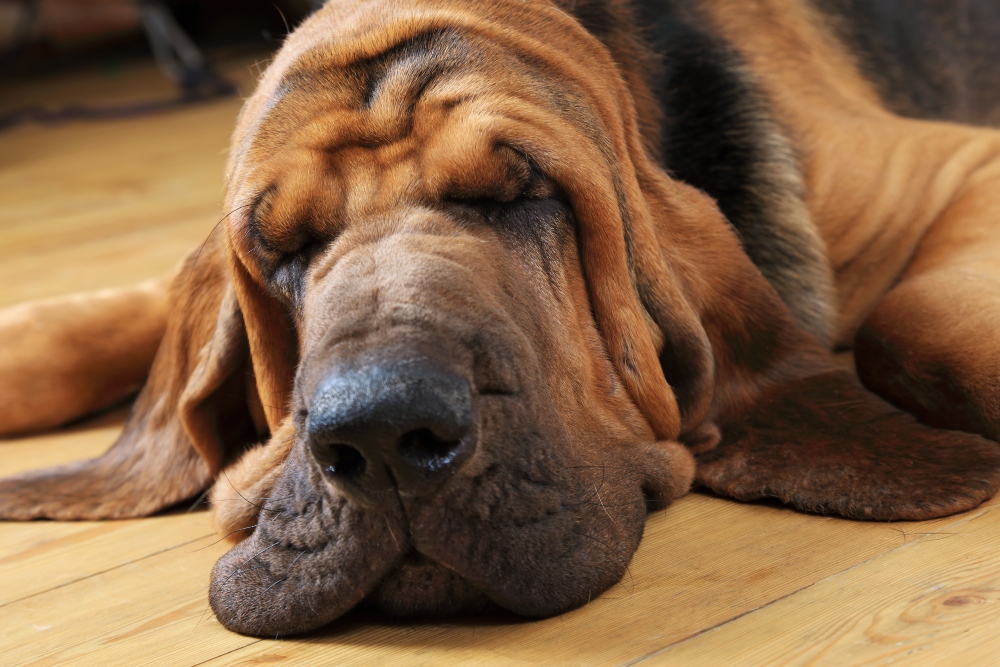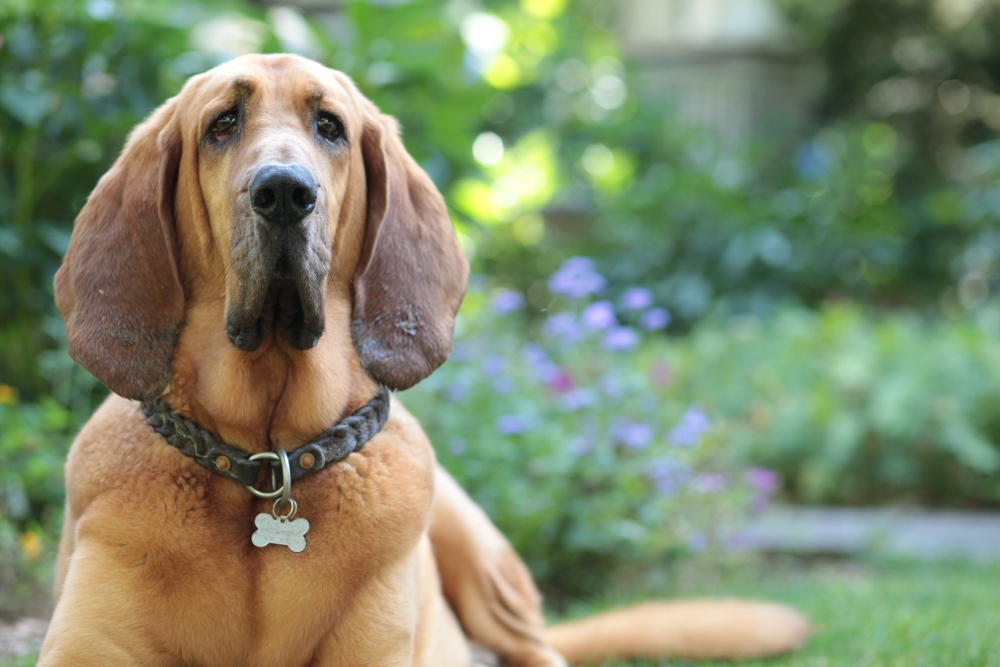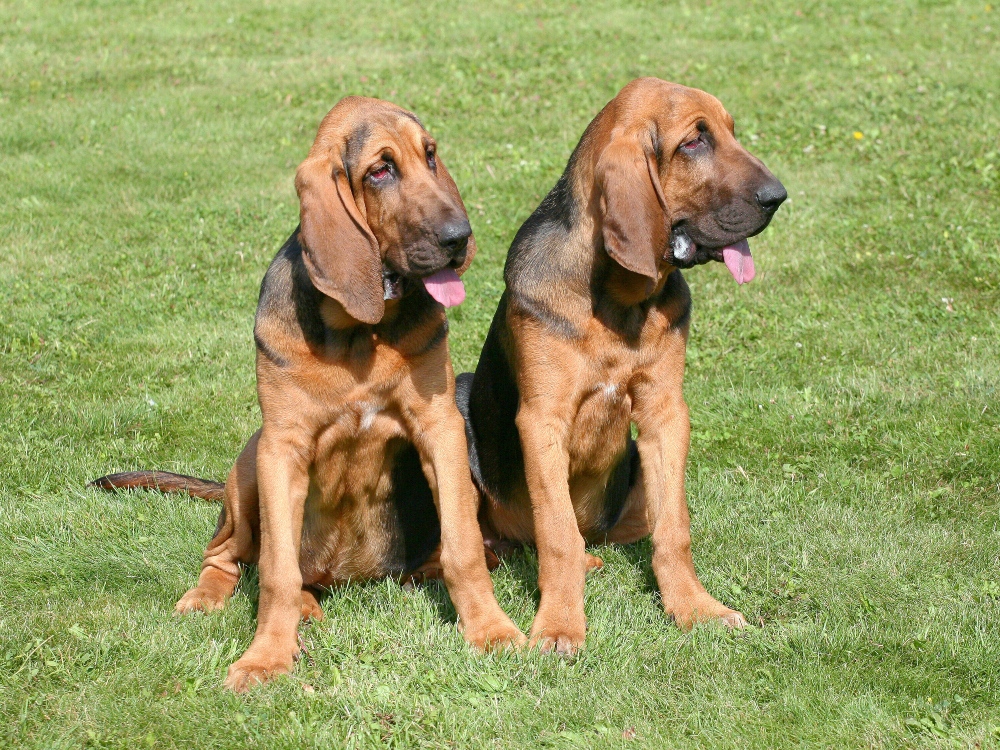Table of Contents
Introduction to Bloodhounds
Although their name may sound intimidating, bloodhounds are very friendly dogs that are curious, independent, and members of the Hound Group of dog breeds. Bloodhounds are especially tolerant of children and can make wonderful pets for the right family. Yet bloodhounds are still actively used as working dogs to assist people who work in law enforcement and search and rescue operations.
With extra-long ears, a strong sense of smell, and an affectionate nature, bloodhounds are large dogs that need plenty of room to move around and be active throughout the day. They are mild-mannered and patient but can be stubborn and challenging for people who aren’t comfortable training and living with dogs. It’s also important for pet parents to be proactive about a bloodhound’s health by keeping up with regular vet checkups and ensuring that the dog is covered by pet health insurance so that costly vet bills don’t get in the way of life-saving treatment.
Size of Bloodhounds
Bloodhounds are large dogs that reach weights of 90 to 110 pounds as males and 80 to 100 pounds as females. Male bloodhounds stand 25 to 27 inches tall, and females are 23 to 25 inches in height when fully grown. You can consider a bloodhound puppy to be fully grown between the ages of 18 and 24 months.
Below is a chart detailing how big you can expect your bloodhound to get as the dog grows from puppyhood to adulthood. Female bloodhounds are at the low end of the range, while males are at the high end of these weights.
| Weight Chart | 3 months | 6 months | 9 months | 12 months | Fully grown |
| Female and Male bloodhounds | 20 – 40 lbs. | 45 – 70 lbs. | 60 – 90 lbs. | 75 – 95 lbs. | 80 – 110 lbs. |
Characteristics of Bloodhounds
The bloodhound is known to be one of the best family dogs among all dog breeds… as long as their family knows what they are getting into! They are very tolerant and friendly around children; however, all dogs and children should be supervised when spending time together. Bloodhounds are extremely affectionate and very energetic. Prospective pet parents should know that the breed is known for excessive drooling, mouthiness, wandering off if not kept contained, and needs a lot of exercise regularly. Plus, they have a distinctive odor that some people find unpleasant.
As you get to know a bloodhound’s personality, here’s what you can expect based on his or her breed characteristics:
| Breed Characteristic | Level (High, Medium, Low) |
| Affectionate with People | High |
| Good with Kids | High |
| Good with Pets | High |
| Need for Exercise | High |
| Energy Level | High |
| Intelligence Level | Medium |
| Able to Be Trained | Medium |
| Amount of Barking | High |
| Amount of Shedding | Medium |

History of Bloodhounds
There is a certain degree of mystery around the origins of the bloodhound. The breed has been linked to the Mediterranean in ancient times, based on the writings of a third-century scholar who described a hound with impressive scenting powers. Over a thousand years ago, bloodhounds were carefully and precisely bred in Western Europe by members of the pre-Reformation church. These dogs worked on the grounds of the monasteries in England and France, and they became known as aristocratic dogs of noble blood.
In modern times, bloodhounds have been used extensively in police work to follow the scents of humans. The records of using bloodhounds for law enforcement purposes date back to 1805 when they were used to find poachers and thieves in England. This is useful when the police are searching for a lost child, elderly adult, or criminal. Bloodhounds are determined and resilient dogs that can continue following a scent for a whole day or even longer. The bloodhound’s sense of smell is greater than even modern forms in technology! Nearly any court of law will accept the results of a bloodhound’s man-trailing when conducted as part of an investigation.
Bloodhound Standard Information
Bloodhounds have a distinctive look, including a long and wrinkled face with loose skin, drooping ears, deep-set eyes, and a solemn expression. These dogs can be various colors and are known for being stubborn and relentless. Other defining physical characteristics of the breed are described in the official breed standard information that is used to judge the dogs at shows and competitions.
Here is an overview of the breed standard information for bloodhounds:
Head:
- Narrow in proportion to length
- Brows not prominent
- Eyes deeply sunk in the orbits
- Ears thin, soft, and extremely long
- Scissors bite preferred but level bite acceptable
- Ample loose skin on the head
Neck, Shoulders, Chest:
- Long neck
- Shoulders well-muscled and sloped backwards
- Chest well let down between forelegs
- Ribs well-sprung
Legs and Feet:
- Forelegs straight and large in bone
- Elbows squarely set
- Strong and well-knuckled-up feet
- Thighs and gaskins very muscular
- Hocks well-bent, let down, and squarely set
Back and Loin:
- Strong with loins deep and slightly arched
- Stern long and tapering, set on high with moderate hair underneath
Color:
- Black, tan, liver and tan, or red
- Darker colors can be interspersed with lighter or badger-colored hair
- Small amount of white is fine on chest and feet
Gait:
- Elastic, swinging, and free
- Stern carried high but not curled over the back

Caring for Bloodhounds
These are not apartment dogs, and they are fairly high-maintenance with regard to the amount of time and attention required. For example, they need at least two hours of exercise per day, such as jogging and hiking.
Here are some more general tips for taking the best care of a bloodhound:
Best Living Environments:
- Houses with fenced yards
- Not apartments
- With pet parents who have plenty of time to devote to them
Type of Exercise:
- Jogging
- Hiking
- Long walks on a leash
- Playtime in the backyard
- At least two hours of exercise daily
Mental Enrichment:
- Playing hide-and-seek to find treats or a family member
- Designated, sturdy chew toys
Training Strategies:
- Bloodhounds can be stubborn, making training difficult
- Use consistency, patience, and only positive training techniques
- Use toys and treats for training
- Very sensitive dogs, so no harsh corrections
- Known to be chewers, so establish which items in the house are acceptable for chewing
Grooming Tips:
- Clean wrinkles daily with damp washcloth and dry them thoroughly
- Clean folds around the mouth
- Clean ears as needed
- Brush coat weekly with rubber mitt or brush
- Sheds seasonally
- Brush teeth and trim nails
- Keep towels on-hand at all times to wipe up slobber and drool
Common Health Problems of Bloodhounds
The average bloodhound lives for 10 to 12 years. Well-bred individuals are generally healthy but still require consistent care and cleaning to maintain good health. If you get your bloodhound puppy from a breeder, you’ll want to make sure that all the recommended health clearances are in place, such as checks for hip and elbow dysplasia, heart disease, patellar luxation, hypothyroidism, degenerative myelopathy (a disorder affecting the spinal cord), and eye diseases.
These are some of the most common health issues that arise with bloodhounds:
- Hip dysplasia
- Elbow dysplasia
- Hypothyroidism
- Entropion and ectropion (eyelid conditions)
- Gastric dilation-volvulus (bloat)
- Fold dermatitis (skin infection in the folds)

Diet and Nutrition for Bloodhounds
Bloodhounds are at elevated risk for gastric dilatation-volvulus (bloat), which is why it is important to feed your adult dog two to three meals per day rather than just one large meal daily. Also, don’t feed your bloodhound right before they go out to exercise or play. You can also try using a slow-feeder bowl with your bloodhound to prevent bloat.
Most adult dogs will thrive when eating a high-quality, nutritionally complete and balanced dog food. Bloodhound puppies should eat a large breed puppy food until they are around 18-24 months old. If you feed your bloodhound homemade dog food, make sure you are working from a recipe that is designed by a veterinary nutritionist and is appropriate for your dog’s age and health status.
Feed the amount of dog food needed to keep your pet slim. You should be able to see your dog’s waist and feel (but not see) their ribs without having to press too hard. In general, puppies need more calories per day than adults, but a dog’s needs will vary with their activity level and other factors. Don’t leave food out all day for a bloodhound to graze on. Divide the total amount of food for the day into at least two or three meals for adults and three or four meals for puppies. Place the food out in a bowl at approximately the same times each day.
Talk to your veterinarian if you have any questions about your bloodhound’s diet or health.
Where to Adopt or Purchase Bloodhounds
The American Bloodhound Club is the parent breed for the club and offers resources for bloodhound education, health articles, and breeder information if you are looking to purchase a puppy. There are also many rescue groups that specialize in finding adoptive homes for these dogs. Rescue groups include the Bloodhound Rescue, Pacific Rim Bloodhound Rescue, Southwest Bloodhound Rescue, Southeast Bloodhound Rescue, and Canadian Bloodhound Club Rescue.
Related Breeds
Pet lovers who are interested in the bloodhound breed may want to learn about other types of hounds that share common characteristics with the bloodhound before deciding to adopt or purchase a pet. Here are some related and similar breeds to the bloodhound:
- Black and tan coonhound
- Bluetick coonhound
- Bavarian mountain scent hound
- English foxhound
- Beagle
- Basset hound
- Dachshund
Pet Insurance for Bloodhounds
Bloodhounds are very active and adventurous dogs, which means that they can easily get into trouble with unforeseen accidents that result in injuries. They are also prone to various genetic and hereditary conditions, which can lead to the emergence of diseases at any age.
To be prepared for whatever comes your bloodhound’s way, sign your dog up for Healthy Paws dog insurance and enjoy peace of mind that you can afford unexpected vet bills if something happens. Our top-rated bloodhound insurance plan covers accidents, illnesses, cancer, emergency care, genetic and hereditary conditions, breed-specific conditions, and alternative care.
Contact us today for your bloodhound pet insurance quote.









